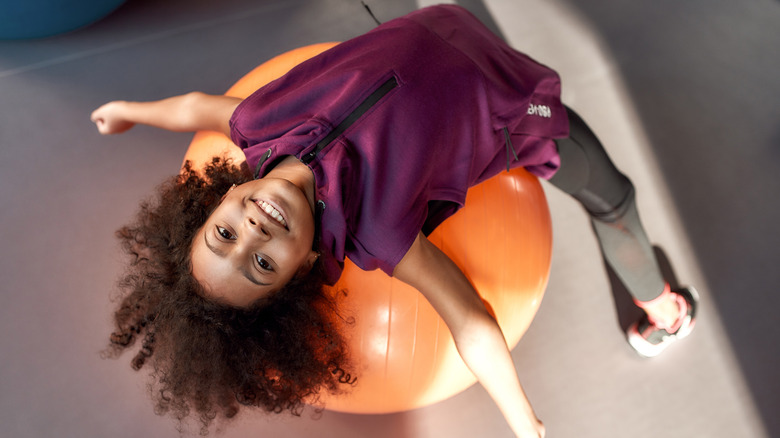You've Been Using Your Exercise Ball All Wrong
Exercise balls are incredibly versatile pieces of fitness equipment. They can be used to improve coordination, balance, and core strength without relying on heavy weights to achieve results. But they can also be deceptively simple. Despite their popularity and versatility, exercise balls are often misused.
Some of the more common mistakes can be blamed on unclear packaging or a lack of communication from trainers. People find out about the benefits of exercise ball routines and hurry to buy one without realizing the variety available.
According to Spine Health, a properly-sized exercise ball will leave a person's feet flat on the floor with their knees either in line with their hips or slightly below. This leaves their thighs almost parallel to the floor. Whether sitting up or laying back, people on an exercise ball should also be able to draw a straight line from their ears to their shoulders and then to their pelvis.
Setting up these lines of stability requires a ball that is the right diameter for a person's height. Most companies offer between three and five sizes and many have charts listed to help people find the right size. Spinal Health takes it a step further, however, and suggests that people with higher than average body weights choose the next size up from the chart's recommendation, as the ball will compress a little more during use. Using one size up from the chart will ensure their technique is not negatively affected.
Technique is everything
The rest of the issues concern technique. As Real Simple puts it, exercise balls require people to engage their cores, which ultimately works to increase their overall stability. Unfortunately many people don't realize that they should be stable on the ball even at the very start of their workouts.
Self explains that one of the most common mistakes people make with exercise balls is tolerating instability. If they fall off the ball or wobble around too much, they're not getting the most out of their workout, while also risking an injury. To avoid this, the site suggests either putting more of your body on the ball or widening your stance to increase your stability.
Moving slower may also help, as it allows you to focus on your technique. And this, as it turns out, eliminates the third most common issue people face when using exercise balls. Self cautions against pushing yourself through any workout without ensuring you have proper form and technique. When it comes to exercise balls, you're risking back injury and falls in addition to the usual potential for straining your muscles.
Exercise balls can be immensely helpful, when used correctly. It's why they're popular as alternatives to office chairs, despite LinkedIn's 2015 post urging bosses to ban their use. But while LinkedIn is worried about employees using exercise balls for fun, people looking to increase core stability can find great success as long as they avoid the common mistakes.


